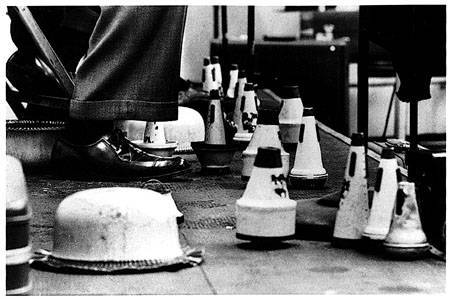
Gordon Parks
photograph, 1960
When people hear the word "jazz" they first think music, but perusing Seeing Jazz they will experience true synaesthesia. The writers who provide text for this volume hear color, and the visual artists - they see, and make their viewers see, rhythms, harmonies, and chords structures. The photographers, as they often do, capture silencesl. Throughout this exquisite catalogue of a touring exhibition from America's Jazz Heritage, a partnership between the Lila Wallace-Reader's Digest Foundation and the Smithsonian Institution, (SITES), the art, poetry, anecdotes, homages, lore and snippets of tunes all contribute to a syncopation, no different than what Ellington wanted from his musicians - to make a "phrase dance."
 | |
|---|---|
|
Untitled (Musician's Feed with Mutes) Gordon Parks photograph, 1960 |
Whitney Balliett writes of Thelonious Monk, "While his sidemen soloed, he stood by the piano and danced, turning in slow, genial circles, his elbows out like wings, his knees slightly bent, his fingers snapping on the after-beat." In "Ask Me Now," E. Ethelbert Miller writes: "like Thelonious Monk/I record my love for you/and no one understands it." And there's "The Lindy Hop," a 1936 lithograph by Miguel Covarrubias quite in tune with Yusef Komunyakaa's lines: "A surge of blue, & my butterfly-toes/Were copacetic & demonic."
One ponders the music-to-see: Sam Gilliam's polychromatics, say or Al Smith's "Bembé Clavé" measuring of rhythms. It's something, to hear Charlie Parker looking at Norman Lewis's ink wash on paper. There are references back to New Orleans, and other jazz roots, as in William Claxton's mostly black photo of "Will Shade and His Tub Bass, Memphis," taken in 1960. And the volume is designed so that sheer symmetry links "Canary," a Rita Dove poem dedicated to Billie Holiday and Dennis Stock's photograph of the songstress with her chihuahua at her feet. On the opposite page, Stock has focuses on a caged canary and "Mary Lou Williams at Her Piano."
Robert O'Meally thoughtfully riffs on "Improvisation" alongside a gorgeously mellow "Jazz" by Man Ray (tempera and ink "aerograph" on paper). Stuart Davis conveys the "unforseen" in "Pad No. 4." If one has lived too far from the oldest jazz club in New York to have ever visited it, Anthony Barboza's photo of Max Gordon's desk in the kitchen "office" of the Village Vanguard hints at its flavor. Consider, too, that James Baldwin wrote "Music is a moment" during intermission at Mikell's, holding court until more spitfire jazz stopped the talk.
Ana Golobart's "Uptown Dance" depicts a woman-centered scene. The gouache in pinks and tangerine tones really gets down in its funky chromatics. At the other end of the jazz spectrum, there's the blues. Raymond Saunders "Blues, Red, Yellow II" (mixed media) visualizes the heart, an enduring subject of jazz lyrics. And Abbey Lincoln unpearls an extended oxymoron:
This piece is featured in MultiCultural Review, a quarterly publication; mcreview@aol.com.
Zoë Anglesey is a New York-based jazz writer, book reviewer, translator and editor of a forthcoming anthology of young generation poets (from One World/Ballantine, in 1999); her work appears in Down Beat, JazzIz and the Village Voice, among other publications.